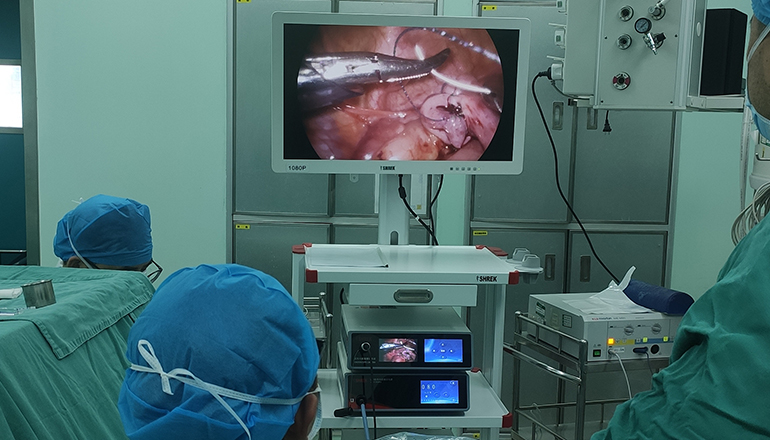- Shanghai, China
- [email protected]
- +86-21-58189111
A right posterior hepatectomy is a surgical procedure that involves the removal of the right posterior section of the liver. This procedure is typically performed to treat certain liver diseases or cancers that affect this area of the liver. Laparoscopic surgery is a minimally invasive approach to this procedure that utilizes small incisions and specialized instruments to perform the surgery.
Here are the general steps involved in performing a laparoscopic right posterior hepatectomy:
Anesthesia: The patient will be given general anesthesia to ensure that they are asleep and pain-free throughout the procedure.
Incisions: The surgeon will make several small incisions in the abdomen to allow access for the laparoscopic instruments. Typically, 3-4 incisions are made for this procedure.

Carbon dioxide insufflation: Carbon dioxide gas will be used to inflate the abdomen, which creates space for the surgeon to maneuver the laparoscopic instruments.
Visualization: The laparoscope, a small camera attached to a thin, flexible tube, will be inserted through one of the incisions. The camera will provide a high-definition image of the surgical site on a monitor, allowing the surgeon to see the liver clearly.
Dissection: The surgeon will use specialized laparoscopic instruments to carefully dissect and separate the right posterior section of the liver from the surrounding tissue and blood vessels.
Control of blood vessels: The surgeon will use a combination of laparoscopic clips and energy devices (such as a harmonic scalpel) to control and seal any blood vessels that are cut during the dissection.
Removal of liver tissue: Once the right posterior section of the liver has been completely dissected and isolated, the surgeon will remove it from the body through one of the incisions.
Closure: The incisions will be closed with sutures or staples, and a sterile dressing will be applied to the surgical site.
Recovery: The patient will be monitored closely in the recovery room for several hours before being transferred to a hospital room. The length of the hospital stay will depend on the patient's overall health and the extent of the surgery.
It's important to note that a laparoscopic right posterior hepatectomy is a complex surgical procedure that should only be performed by a highly trained and experienced surgeon. Patients who are considering this procedure should discuss the risks and benefits with their surgeon and carefully consider all options before making a decision.
Some potential risks and complications associated with laparoscopic right posterior hepatectomy include bleeding, infection, damage to surrounding organs or blood vessels, and blood clots. Recovery time can vary depending on the patient's overall health and the extent of the surgery, but most patients can expect to return to normal activities within several weeks to months after the procedure.
In conclusion, a laparoscopic right posterior hepatectomy is a complex surgical procedure that involves the removal of the right posterior section of the liver. This procedure is typically performed to treat certain liver diseases or cancers that affect this area of the liver. The laparoscopic approach is a minimally invasive option that utilizes small incisions and specialized instruments to perform the surgery. Patients considering this procedure should discuss the risks and benefits with their surgeon and carefully consider all options before making a decision. It is important to choose an experienced surgeon with a high success rate in performing this procedure to minimize the risk of complications and ensure the best possible outcome.
Leave a Comments